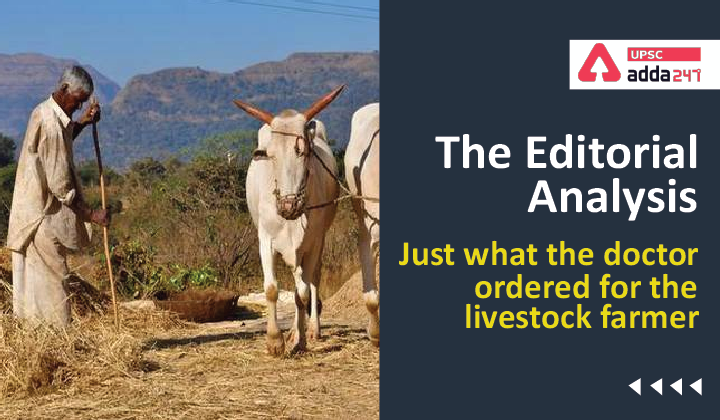Table of Contents
Mobile Veterinary Units: Relevance
- GS 3: Economics of animal-rearing.
Mobile Veterinary Units: Context
- According to the 20th Livestock census, India has a total livestock population of approximately 537 million. Out of the total population, around 96% is concentrated in rural areas.
Issue of veterinary services
- The M.K. Jain Committee Report has highlighted that livestock farmers face greater challenges in comparison to traditional agricultural farmers especially while accessing credit and livestock insurance.
- Access to veterinary services is a major challenge in rural and remote areas of our country.
- Livestock farmers are often compelled to travel far from their villages whenever their animals need treatment.
- It adversely impacts the longevity and the productivity of their livestock.

Focus of the government
- Government has revised the provisions of Livestock Health and Disease Control (LH&DC) programme where the focus has been on ‘Establishment and Strengthening of Veterinary Services – Mobile Veterinary Units (MVUs)’.
- Earlier, the Government was providing doorstep services related to artificial insemination and vaccination for livestock.
- The MVUs will build on the doorstep delivery model, as stationary hospitals cannot be easily accessed by most livestock farmers.
Benefits of Mobile Veterinary Units (MVUs)
Address the issue of testing facility
- A Parliamentary Standing Committee has observed that inadequate testing and treatment facilities for veterinary diseases pose a major challenge, especially now where there is a drastic rise in cases of zoonotic diseases.
- Most villages in the country lack testing facilities, and even when samples are collected, they need to be sent to blocks/districts nearby for test results.
- So, MVUs can play a major role in plugging the gap in this regard.
Reduce antibiotic resistance
- Problems pertaining to antimicrobial resistance occur when the animal no longer responds to a drug to which it was originally responsive.
- The MVU model will mitigate the issue of antimicrobial resistance and is in alignment with the ‘One Health vision’ laid down by the Global Action Plan of WHO.
Avoid milk losses
- 70% of India’s milk supply is sourced from farmers who own less than five animals, and losses due to mastitis alone amount to a milk loss of approximately 10 litres per day per farm.
- Bovine mastitis is a condition typified by the persistent and inflammatory reaction of the udder tissue due to either physical trauma or infections caused by microorganisms.
- The loss roughly translates into ₹300-₹350 per day.
- So, for most farmers, death of or disease in livestock could mean the difference between sustenance and starvation.
- MVUs have been successfully in several states with positive results and increased outreach, especially in geographically difficult terrains.
Provide employment
- The increasing adoption of MVUs across the country will lead to a surge in employment opportunities for veterinarians and assistants.
Also Read:




 TSPSC Group 1 Question Paper 2024, Downl...
TSPSC Group 1 Question Paper 2024, Downl...
 TSPSC Group 1 Answer key 2024 Out, Downl...
TSPSC Group 1 Answer key 2024 Out, Downl...
 UPSC Prelims 2024 Question Paper, Downlo...
UPSC Prelims 2024 Question Paper, Downlo...





